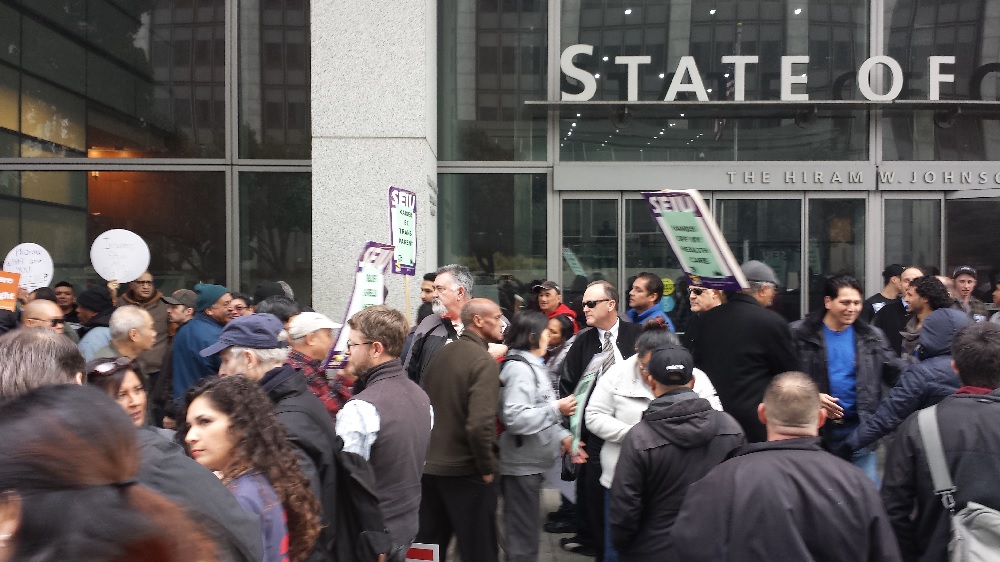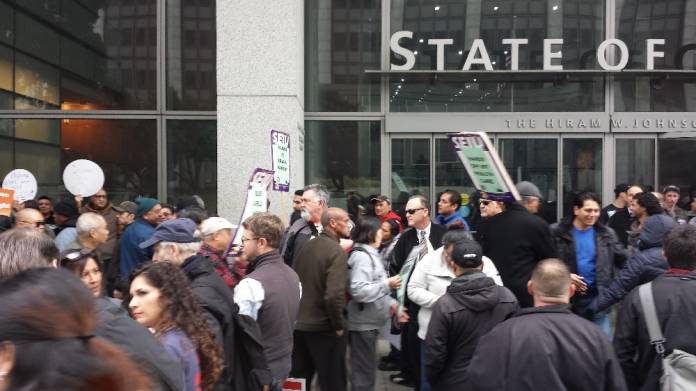More than a thousand people (my estimate) showed up today at the state building to weigh in on health-care costs – and make the case for a single-payer system in California.
Former state Sen. Mark Leno managed in 2015 – over the fierce resistance of the health-insurance industry – to get a bill passed that requires insurance companies to provide some clear data on their rate hikes and the reasons behind them.

The bill also mandated that state regulators hold a hearing once a year, in either San Francisco or LA – and this year, it was in the Milton Marks Auditorium in the state building.
Outside, a huge and loud crowd of mostly labor folks marched and rallied and made clear that the current system isn’t working.
Inside, testimony made that even more clear.
Leno noted that price increases have been somewhat lower since his bill passed. Although the measure doesn’t give the state the authority to regulate rates, just the transparency requirements have helped keep costs a bit more under control.
But he noted (as did others) that pharma companies and hospitals continue to charge at times outrages amounts for goods and services – and “if the insurance companies can’t negotiate a better price, then maybe the government should take over that role with a single-payer system.”
That brought applause. Pretty much everyone in the audience agreed that single-payer would be cheaper and more effective.
Some of the information was just crazy.
The average cost for health care for a family of four is $25,000 a year. That’s many times higher than the cost in most Western democracies that have a national health-care system – and the outcomes, by any measure of health, are worse in the US.
A member of UNITE HERE Local 2, which represents hotel and restaurant workers, talked of how every year the union has to decide how much money to allocate to pay increases – and how much to health care. It’s painful: Older workers need health care, but younger workers can’t afford to live in the city without pay hikes.
“My employer pays $12 an hour for our health care fund,” one UNITE HERE member noted.
Mike Casey, a longtime Local 2 leader, confirmed that to me: $12 an hour, much of which could be going to higher wages, winds up in the pockets of the health insurance companies.
I have always wondered why industrial capitalists don’t support single-payer — it would make General Motors more competitive and profitable. But as Casey told me, the CEOs are all part of the same game: “Big investment groups own the hotels and the insurance companies,” he said.
That was a theme all afternoon. “Where did my raise go?” asked stickers worn by workers. “To the CEO at Kaiser,” one of them told me.
That, and Big Pharma.
Data that the state has gathered shows that a significant amount of the money that goes to health-insurance payments is spent on vastly overpriced prescription drugs.
“There is still a lack of transparency about pharmaceutical costs,” Li Lovett, a teacher and union activist at City College, testified.
Assemblymembers David Chiu and Phil Ting both send representatives to speak. Either one talked about single-payer as the only solution.
But that’s what many of the labor people on hand today are pushing – and it’s going to be a serious campaign this year. As the Trump Administration looks to gut and repeal the Affordable Care Act, California isn’t going to have many options: Either we accept that two million people will lose their health insurance, or we push back – seriously.
The regulators who held the hearing today have no authority to make policy; as a long line of people spoke of the horrors of the current system, they could do nothing but listen. I wish the governor had been forced to sit and listen.
But UNITE HERE had a videographer tape the whole event, and it was powerful and moving, and as Casey said, “it’s going on the road.”
And the Democrats who control California are going to have to make clear: Are they really going to oppose Trump (by supporting single-payer) – or are they going to let the insurance industry and Big Pharma continue to control a dysfunctional health-care system?





